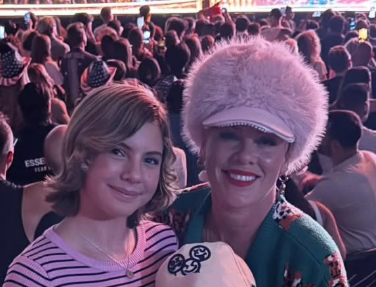Willow Sage Hart’s creative awakening and her transition into adolescent are happening at remarkably similar times. In a recently published photo from her first day of high school, the 14-year-old daughter of Pink and motocross veteran Carey Hart exuded poise and confidence. She balanced youthful appeal and emerging elegance with her ensemble, which consisted of a cropped salmon button-up, blue jeans, and a white belt. She looked like someone who was eager to write her own tale rather than just live in someone else’s shadow, complete with side-parted hair from the 1970s and a pair of thermoses.

By September 4, the picture had started making the rounds on Instagram, garnering praise for Willow’s apparent maturity. Carey sent an emotional statement as a caption for the picture, which depicted a daughter on the verge of transforming her childhood aspirations into genuine ambition and showed more than just a proud father’s love. He wrote, “It’s so crazy that Willz is starting high school today.” One day, you’ll be on Broadway. Very pleased with you.
Willow Sage Hart – Personal & Career Snapshot
| Category | Details |
|---|---|
| Full Name | Willow Sage Hart |
| Date of Birth | June 2, 2011 |
| Age | 14 years old (as of 2025) |
| Parents | Alecia Beth Moore (Pink), Carey Hart |
| Siblings | Jameson Moon Hart (Younger Brother) |
| Career Aspiration | Theater and Broadway Performer |
| Notable Appearances | On-stage with Pink, social media features, school events |
| Style Icon Moment | Salmon crop shirt & white belt on first day of high school |
| Family Philosophy | Authenticity over fame; individuality over perfection |
| Reference |
That desire to be on Broadway is more than simply a token gesture. It’s a path influenced by exposure and experience. One of pop’s most emotionally expressive vocalists and stage performers is subtly molding Willow, who has performed with her mother on stages all over the world. Her voice has already showed potential; it is unpolished, raw, and incredibly effective in its delivery. Willow’s elegance and clarity in previous performances, particularly in Berlin, left listeners in amazement. There was something very obvious about her presence: she was there to connect, not to impress.
Willow’s story is further complicated by Pink’s parenting philosophies. Pink stressed the value of instilling self-awareness among her children instead of spotlight hunger in a post from October 2024. “As long as my children are being true to themselves, I am content. They’re not a-holes, either,” she wrote. Thousands of followers found resonance in the message, which was both hilarious and grounded. It demonstrated how Willow’s identity is being developed in a household that values morality over fame.
Around the same time, Willow’s younger brother, Jameson Moon Hart, started a new school year. He wore orange sneakers, multicolored shorts, and a white blouse. Although his arrival was more lighthearted—his father jokingly said, “Jamo, just don’t eat too much glue”—it demonstrated the family’s incredibly effective parenting style, which embraces each child’s individual rhythm without requiring uniformity. Children raised in public may benefit most from this balance of order and freedom.
For Willow as well as the greater culture surrounding celebrity offspring, Willow’s move to high school represents a critical turning point. The Hart family has chosen a very different path in an era where a lot of children of well-known parents are thrust into social media celebrity by middle school. Pink and Carey have made a calculated decision to protect Willow from needless attention and let her pursue her interests naturally. Instead of fostering viral moments, they are fostering longevity.
When viewed through the prism of Broadway, this journey becomes even more tragic. A generational refresh has been taking place in the theater industry. Casting directors are favoring new talent that gives depth over glitz, as evidenced by musicals like Six and Be More Chill, which feature youthful, strong vocals. Willow is a strong contender for this changing environment because of her genuine stage presence and early musical training. She offers a subdued but notably creative substitute for the frequently produced pop princess route.
The legacy factor is another. Historically, performers’ children have been examined closely under a microscope of expectations. Others travel choppier roads, while others, like Miley Cyrus and Zoë Kravitz, carry the mantle with style. What distinguishes Willow is her parents’ noticeably better approach. They appear to be grooming her for meaningful contribution rather than spotlight survival. She is being positioned to develop a voice rather than merely a resume through narrative, art, and music.
Public events, such as the first day of high school, convey emotional context in addition to visual signals. Carey’s caption aimed to convey belief rather than merely record a significant event. That optimism is significant. The entertainment business has been emphasizing journeys rooted on family legacy and mentoring in recent years. That cultural arc is ideally suited to Willow’s story. Meaningful steps are more important than quick fame.
Her future profession could have an impact that goes beyond red carpets and applause. Having role models who are permitted to develop gradually and truthfully is shockingly uncommon and extremely valuable in the context of contemporary young identity. Teenagers facing internet pressures and forming their own identities might learn from Willow’s obvious joy and grounded demeanor.
Even her modest, understated, yet self-assuredly chosen wardrobe selections convey a lot. At a time when many teenagers are fixated on fashion, Willow’s laid-back elegance felt like a welcome counterpoint. It wasn’t a clicks costume. It was a reflection of a person who was incredibly confident in herself. Perhaps the most permanent gift her parents have given her is that comfort, which they have purposefully fostered.











